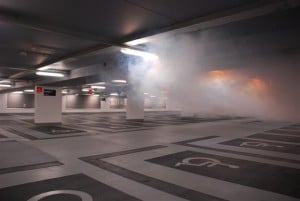 As a designer working on a car park project, there are important considerations you will need to make about ventilation to ensure good air quality. Approved Document F (ADF) stipulates that sufficient ventilation must be provided to enclosed car parks to avoid an excessive build up of carbon monoxide (CO).
As a designer working on a car park project, there are important considerations you will need to make about ventilation to ensure good air quality. Approved Document F (ADF) stipulates that sufficient ventilation must be provided to enclosed car parks to avoid an excessive build up of carbon monoxide (CO).
The simple solution
In your design, you will need to take all measures to ensure that CO levels average less than 30 parts per million (ppm). The ADF suggests that one way to achieve this is to provide for six air changes per hour (ACH). This simple prescriptive option is normally chosen because in the design stage it is very hard to model what the CO levels will be. In addition, a six ACH system is very easy to design and enforce.
An expensive solution?
In practice, CO levels in a car park will vary during the day, depending on the levels of traffic. This means that running car park ventilation systems at six ACH continuously is likely to lead to unnecessarily high energy costs, as the full six ACH is generally only required when dealing with peak conditions.
An alternative to cut operating costs
One solution is to fit CO detectors which measure the levels of CO and controls to reduce the ventilation rate below 6 ACH if the CO is lower than 30 ppm. This inevitably adds to initial costs but has become the norm due to the significant savings in energy costs.
The effect on attenuation
An additional potential benefit of being able to run the ventilation system at a lower ventilation rate may be that the attenuation requirements could, arguably, be reduced.
The question is, should the attenuation be designed for the, often limited, period when the ventilation needs to run at the full six ACH or for a lower “everyday” ventilation rate? The reduction in attenuation needed can save significant space and cost. Regulations and standards are silent on this matter.
How much attenuation do we need?
I suspect the answer may not be simple. Some car parks may operate regularly at near peak conditions whereas others do not. Should we differentiate between say shopping centre and theatre car parks and residential car parks? Should we design the discharge attenuation to meet planning constraints at six ACH but allow internal noise levels to increase above the normally accepted NR55 (as set out in CIBSE Guide volume A) at peak times? What do you think?
Webinar 10/06/16 - Car park ventilation
I will be hosting a live webinar on car park ventailtion, where I will explain this topic in more detail. This webinar will be CIBSE CPD accredited and will feature a Q&A at the end.
Whitepaper - Designing car park ventilation systems
For more detailed information on car park ventilation, you can read our Whitepaper.
 Conor Logan is Associate Technical Director of Colt UK, Smoke and Climate Control Division. Conor designs innovative smoke control and HVAC systems and is also Chairman of the Smoke Control Association.
Conor Logan is Associate Technical Director of Colt UK, Smoke and Climate Control Division. Conor designs innovative smoke control and HVAC systems and is also Chairman of the Smoke Control Association.




